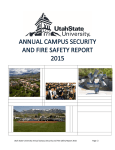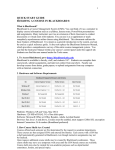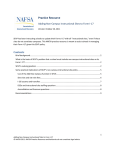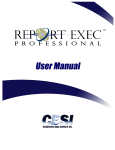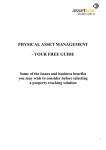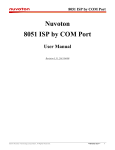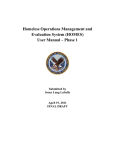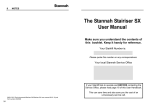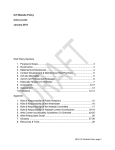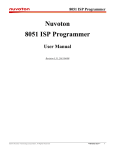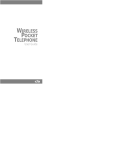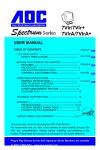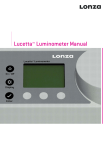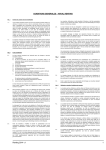Download 2015 Annual Campus Security and Fire Safety Report
Transcript
INTRODUCTION The Annual Campus Security and Fire Safety Report is provided to students, faculty, staff, and the public as part of Utah State University Eastern commitment to safety and security on campus, and in compliance with the Jeanne Clery Disclosure of Campus Security Policy and Campus Crime Statistics Act (Clery Act). This report is prepared in cooperation with various Utah State University departments, which provide annual updated information on their educational efforts and programs to comply with the law. Campus crime, arrests, and referral statistics include those reported to the Utah State University Eastern Police Department (USUEPD), other local law enforcement and fire agencies, and designated campus security authorities. The information contained in this report is intended to educate students and their families about the policies, procedures, and programs that exist to assist in protecting the safety and wellbeing of campus constituents. The Act was recently amended by the Violence Against Women Reauthorization Act of 2013 (VAWA) to include reporting incidents of dating violence, domestic violence and stalking. VAWA requires certain policies and procedures to be in place to reduce these crimes and meet the needs of victims. This information is included in this report. The Clery Act The Clery Act is named for Jeanne Clery, a nineteen-year-Old Lehigh University student who was raped and killed in her dorm room in 1986. The law was originally enacted in 1990 as the Crime Awareness and Campus Security Act (Title II of Public Law 101–542), which amended the Higher Education Act of 1965 (HEA). The Clery Act requires all postsecondary educational institutions participating in Title IV student financial aid programs to disclose campus crime statistics and security information. Specifically, higher education institutions subject to the law must do the following: Collect, report, and disseminate crime data Develop policies, policy statements and procedures regarding campus safety Prepare and distribute an annual security report Issue timely warnings and emergency notifications to the campus community Submit crime statistics to the Department of Education Preparing the Annual Security Report This document is designed to provide students and employees with information concerning personal safety and university policies, and to comply with federal law. The report is prepared on an annual basis by the USU Clery Compliance Committee. For additional information or to submit changes and corrections, please contact Steve Mecham at 435-797-1935 or at [email protected]. CAMPUS LAW ENFORCEMENT AUTHORITY Utah State University Eastern Police Department (USUEPD). The officers in the USUEPD have full peace officer status under state statute, including the authority to make arrests (53B-3-105). Part-time security officers help keep the campus safe. They do not have authority to make arrests. University Police has jurisdiction over and investigates all law enforcement related issues occurring on the Utah State University Eastern campus. Crimes in progress, suspicious circumstances, medical emergencies, and other campus emergencies should be immediately reported to the University Police. A University officer will respond to investigate and will initiate an incident report. Follow-up investigation will be conducted as needed. Page | 2 When dialing 911, campus phones and cell phones connect directly with the Price Public Safety Dispatch. Dispatchers then forward the call to the University Police Department. USU Eastern Police Department Price, UT 84501 435-613-5612 435-613-5677 Emergency: 911 Dispatch Non-Emergency: 435-637-0890 The primary objective of the USUEPD is to provide a campus environment where students, faculty and staff feel safe to pursue the academic mission of the University without the fear of crime. Some of the steps to ensure safety objectives taken by Utah State University include: USUEPD is staffed 24 hours every day. The department provides 24-hour police coverage with its 7 state certified police officers. A USUE police officer provides safety patrols, responds to all reports of crime or suspicious activity and conducts follow-up investigations on all leads. The Price City Fire Department and USUEPD respond to reports of fire and medical emergencies on campus. All officers receive ongoing training under regulatory guidelines established by the Utah Department of Public Safety. This training includes such areas as crime prevention, domestic violence, active shooter, criminal investigation, first aid, firearms, defensive tactics, crowd control, traffic accident investigation, constitutional and statutory law, etc. REPORTING CRIMES AND EMERGENCIES Utah State University Eastern encourages accurate and prompt reporting of all crimes, suspicious activity, and emergency situations. University police is the preferred contact for reporting campus crimes and emergencies. For non-emergencies call 435-613-5612 or Price Public Safety Dispatch 435-637-0890. For emergencies call 911. Students and others can report Clery crimes that occurred in Clery geographic locations to the Police Department and Campus Security Authorities for the purpose of making timely warning reports and inclusion in the annual statistical report. Campus Security Authorities Campus Security Authorities (CSAs) are University officials whose functions involve relationships with students that could result in them receiving reports of crime. They have significant responsibility for student and campus activities. Utah State University Eastern will identify and notify CSAs of their duties and responsibilities. On-line training will be provided when they are hired and annually thereafter. They are given a crime survey annually and are required to report Clery Crimes to the USUPD that occurred in Clery geographic locations and were reported to them during the previous year for inclusion in the Annual Campus Security Report. Individuals who do not want to contact police may confidentially report a crime to a CSA for inclusion in the annual crime statistics disclosure. Page | 3 Professional and Pastoral Counselors University professional counselors are encouraged to make individuals aware that they may report crimes anonymously to a Campus Security Authority for inclusion in the annual disclosure of crime statistics. Utah State University Eastern does not employ pastoral counselors. A professional counselor is a person whose official responsibilities include providing mental health counseling to members of the campus community and who is functioning within the scope of his or her license or certification. This definition applies even to professional counselors who are not employees of the university but are under contract to provide counseling to the campus community. The professional counselor exemption is intended to ensure that these individuals can provide appropriate counseling services without an obligation to report crimes they may have learned about. This is similar to the privilege provided under certain circumstances to doctors and attorneys when they may learn of crimes from patients or clients. This exemption is intended to protect the counselor-client role. However, even these legally recognized privileges acknowledge some exemptions, such as certain situations in which counselors are in fact under a legal obligation to report a crime. To be exempt from disclosing reported offenses, professional counselors must be acting in the role of professional counselor. An individual who is not yet licensed or certified as a counselor, but is acting in that role under the supervision of an individual who meets the definition of a professional counselor, is considered to be one for the purposes of the Clery Act. An example is a USUE Ph.D. counselor-trainee acting under the supervision of a professional counselor. However, a professional staff member in Student Services who has a professional counselor’s license, but who is employed by the university only as a staff member and not as a counselor, is not exempt from reporting. If that same staff member is employed by USUE as both a professional counselor and an academic counselor, and he or she learns of a criminal incident while he or she is engaged in academic counseling, he or she is not exempt from reporting that incident. If an individual has dual roles, one as a professional counselor and the other as an official who qualifies as a campus security authority, and the roles cannot be separated, that individual is considered a campus security authority and is obligated to report Clery crimes of which they are aware. An individual who is counseling students and/or employees, but who does not meet the Clery definition of a professional counselor, is not exempt from being a campus security authority if they otherwise have significant responsibility for student and campus activities. This includes positions such as the director of the Student Health and Wellness Center or the director of the Center for Women and Gender, etc. LOCAL LAW ENFORCEMENT AGENCIES The USUEPD has a close working relationship with the Price City Police Department, the Carbon County Sheriff’s Office, the Helper City Police Department, the Wellington City Police Department, East Carbon City Police Department and other law enforcement agencies throughout the State of Utah. University Police personnel brief with local law enforcement agencies to exchange ideas and discuss problems which may be of concern to the University community. Because the USUEPD has full police authority by state statute there is no memorandum of understanding with local police departments regarding the investigation of alleged criminal offenses. Price City Police Department Page | 4 Students may report crimes that occur off campus to the Price City Police Department, whose jurisdiction includes all off-campus student housing facilities within the Price City limits. Because housing facilities of non-campus student organizations are not university property, the Price City Police Department provides services for these locations. The Price City Police Department is located at the following location: 910 N 7th E Price, UT 84501 435-636-3190 Emergency: 911 Dispatch: 435-637-0890 Carbon County Sheriff’s Office Students living in the county and unincorporated areas of the county may report crimes that occur off campus to the Carbon County Sheriff’s Office. Because housing facilities of non-campus student organizations are not university property, the Carbon County Sheriff’s Office provides services for these locations. The Carbon County Sheriff’s Office is located at: 240 West Main Street Price, UT 84501 435-636-3251 Emergency: 911 Dispatch: 435-637-0890 Helper City Police Department Students may report crimes that occur off campus to the Helper City Police Department, whose jurisdiction includes all off-campus student housing facilities within the Helper City limits. Because housing facilities of non campus student organizations are not university property, the Helper City Police Department provides services for these locations. The Helper City Police Department is located at the following location: 97 South Main Street Helper, UT 84526 435-472-3719 Emergency: 911 Dispatch: 435-637-0890 Page | 5 Wellington City Police Department Students may report crimes that occur off campus to the Wellington City Police Department, whose jurisdiction includes all off-campus student housing facilities within the Wellington City limits. Because housing facilities of non-campus student organizations are not university property, the Wellington City Police Department provides services for these locations. The Wellington City Police Department is located at the following location: 150 West Main Street Wellington, UT 84526 435-637-4830 Emergency: 911 Dispatch: 435-637-0890 East Carbon Police Department Students may report crimes that occur off campus to the East Carbon Police Department, whose jurisdiction includes all off-campus student housing facilities within the East Carbon, Sunnyside, Columbia City limits. Because housing facilities of non-campus student organizations are not university property, the East Carbon Police Department provides services for these locations. The East Carbon Police Department is located at the following location: 101 West Geneva Drive East Carbon, UT 84520 435-888-2081 Emergency: 911 Dispatch: 435-637-0890 CRIME AWARENESS AND PREVENTION PROGRAMS Several crime prevention programs available to campus groups teach people ways to protect themselves and their property and encourage the immediate reporting of all crimes or suspicious incidents. These programs include the following: 1. USUEPD participates in the freshman orientation each fall semester. They also participate in the International Student Orientation program during the fall, spring, and summer semesters. Additionally, they participate in the SOAR (Student Orientation and Advising and Registration) program during the summer for incoming freshman or transfer students and their parents. 2. USUE security or police officers provide a 24-hour walking escort to students or employees to and from campus destinations. Page | 6 3. Other presentations that include: Alcohol awareness – effects, impairment, laws and USUE’s rules Theft – identify and document belongings, how to secure belongings, etc. Workplace violence/Active shooter – warning signs, what to do, how to protect yourself Crime prevention – overall crime prevention practices and tips Personal Safety-practices and tips Resident Hall Assistan safety and awareness orientation-assist resident hall assistant (RA’s) to educate students living in the residence halls (personal safety, emergencies, housing policies) TIMELY WARNING NOTIFICATION POLICY In the event of that a serious incident is reported to the USUEPD which may pose a serious or ongoing threat to members of the USUE community, a timely warning will be sent to all students and employees on campus via blast email through the USUE Code Blue Emergency Alert System. The alerts are written by the USU Logan Police Chief, the Assistant Police Chief, or a designee and are approved by the Vice President for Student Services and/or the Vice President for Business and Finance or designees. The USUE Emergency Manager or a trained designee will distribute the crime alert. Crime alerts may also be distributed through the student newspaper, The Eagle, posting fliers in affected areas, or local radio stations. Crime Alerts will be provided to students and employees in a manner that is timely, that withholds the names of victims as confidential, and that provides information to assist with potentially preventing similar occurrences. Crime Alerts are usually distributed for the following Uniform Crime Reporting Program (UCR)/National Incident Based Reporting System (NIBRS) classifications: major incidents of arson murder/non-negligent manslaughter burglary robbery The following UCR/NIBRS cases are considered on a case-by-case basis depending on the facts of the case and the information known by University Police: aggravated assault sex offenses For example, if an aggravated assault occurs between two students who have a disagreement, there may be no ongoing threat to other USUE community members and a Crime Alert would not be distributed. Cases involving sexual assault are often reported long after the incident occurred, thus there is no opportunity to distribute a “timely” warning notice to the community. Sex offenses will be considered on a case by case basis depending on when and where the incident occurred, when it was reported, and the amount of information known by the USUE Police Department. Timely warnings may be issued for other Clery Act crimes when the USUE Police Department determines such crimes pose a serious or on-going threat to students and employees. The Chief of Police, the Assistant Chief of Police or a designee reviews all reports to determine if there is an on-going threat to the community and whether the distribution of a Crime Alert is warranted. Page | 7 Anyone with information warranting a “timely warning” should report the circumstances to the USUE Police Department by phone at 435-613-5612 or contact Price Public Safety by phone at 435-637-0890. MISSING PERSON POLICY The Clery Act requires institutions that maintain on-campus housing facilities to establish a missing student notification policy and related procedures. The term “missing student” for this policy refers to any Utah State Eastern University student who is residing in on-campus student housing who is reported missing from a residence. Every student who resides in on-campus housing may confidentially register one or more individuals to be a contact strictly for missing persons purposes. The contact person can be anyone. Only authorized campus officials and law enforcement officers in furtherance of a missing person investigation may have access to this information. This information will not be disclosed outside of a missing person investigation. Even if a resident does not register a contact person, law enforcement will be notified if the resident is reported missing. If anyone has reason to believe that a student who resides in on-campus housing is missing, he or she should immediately notify USUE Housing and Residence Life staff at 435-???-???? or contact the Resident Director (RD) or Resident Assistant (RA) in the affected residence hall (click here for a directory of the residence halls). The Utah State University Eastern Police Department can also be contacted at 435-637-5612, 435-613-5677 or by contacting Price Public Safety Dispatch who will contact the USUE Police Department. If the report of a missing resident of on-campus housing is received by any Housing and Residence Life staff member, the report shall immediately be referred to the University Police Department. The University Police Department will immediately initiate an investigation of any missing person report. Should the investigation result in the conclusion that the student is missing, and has been missing for 24 hours, the Price City Police Department or the local law enforcement agency which would have jurisdiction for the reported incident. The student’s missing person contact shall be notified within 24 hours of that determination. If the missing student is under the age of 18, and not an emancipated individual, the student’s parent or legal guardian will be notified within 24 hours of a determination that the student is missing, in addition to notifying any additional contact person designated by the student. DATING VIOLENCE, DOMESTIC VIOLENCE, SEXUAL ASSAULT, AND STALKING POLICIES AND PROCEDURES Utah State University Eastern prohibits the crimes of sexual assault, dating violence, domestic violence, and stalking (as defined by the Clery Act) and reaffirms its commitment to maintaining a campus environment that emphasizes the dignity and worth of all members of the university community. Toward that end, Utah State University Eastern issues this statement of policy to inform the campus community of our programs to address domestic violence, dating violence, sexual assault and stalking as well as the procedures for institutional disciplinary action in cases of alleged dating violence, domestic violence, sexual assault, or stalking, which will be followed regardless of whether the incident occurs on or off campus when it is reported to a University official. University employees, including faculty, staff, and administrative employees, who become aware of or reasonably suspect any sexual assault, dating violence, domestic violence, or stalking incidents should report the information to the University Police (435-613-5612, 435-613-5677) or the Title IX Coordinator in Page | 8 Affirmative Action/Equal Opportunity office. The Affirmative Action/Equal Opportunity office is located in Reeves Building 451 E 400 N inside the Human Resource Office (435-613-5678). A dean, department chair, manager, supervisor, professor, or any other university employee, who receives a report of sexual misconduct, including sexual harassment or sexual violence, must promptly refer the reporting individual to the Title IX Coordinator in the Affirmative Action/Equal Opportunity office. If a report of sexual misconduct involves potentially criminal acts (i.e., rape, acquaintance rape, domestic violence, dating violence, sexual assault, or stalking), the alleged victim should be informed that she or he also has the option of reporting the incident to the University Police at 435-613-5612, 435-613-5677 or the Price City Police at 435-636-3190, and the option to be assisted by campus personnel in notifying such authorities. The University Police will notify the Title IX Coordinator of all such reports received. Persons who have reason to believe that a child (anyone under 18 years old) has been subjected to sexual violence or other forms of abuse or neglect, or who observe a child being subjected to conditions or circumstances which would reasonably result in such abuse or neglect, must report the situation to the nearest peace officer, law enforcement agency, or applicable office of the state Division of Child and Family Services, as required by state law. Procedures to Follow if a Sex Offense, Dating Violence, Domestic Violence, or Stalking Occurs Incidents of on-campus dating violence, domestic violence, sex offenses, or stalking should be reported to the University Police at 435-613-5612, 435-613-5677 or by calling 911 in emergencies. Off-campus incidents should be reported to appropriate local law enforcement officials. If desired, personnel from Student Services or the SAAVI office will assist a victim in notifying the appropriate law enforcement authorities when any of these offenses occur. A victim of these offenses has the option to decline to notify law enforcement but may still report the incident to the Title IX Coordinator (435-613-5678). Prompt reporting helps the victim receive medical assistance, counseling, or other support services (e.g. housing relocation, change in classes, etc.) and allows for the collection and preservation of crucial evidence. It is important to preserve evidence that may assist in proving that the alleged criminal offense occurred. Victims have a right to seek a protective order against an aggressor from the courts. The Carbon County Victim Advocate (435-636-3250) can assist in obtaining protective orders. Preserved evidence may be helpful in obtaining a protective order. If a victim obtains a protective order, a copy of that order should be brought to the USU Eastern Police Department so they are aware of it. Protective order violations will be enforced when they occur on the USU Eastern campus. In appropriate cases Utah State University Eastern will issue no contact orders as part of the campus judicial process. Procedures to Follow if You Become a Victim of a Sex Offense Victims of sexual assault should do the following: Escape and go to a safe place as soon as possible Preserve all physical evidence (do not bathe, douche, brush teeth, wash hands, or change clothing) Use a clean jar to collect any urine Find a trusted individual to provide moral support and company Use the campus and community resources listed in this publication to aid in recovery Do not change clothes or shower. Seek medical attention if needed. Save all text messages and emails that you receive from the suspect. Save all text messages and emails you send or those you receive from friends in reference to the incident. Report the offense immediately to the police. If you live in a campus residence hall, your resident director or resident assistant can help you contact the proper authorities. Page | 9 Seek medical attention. If you do not want to contact the police, you may contact the SAAVI Office or CAPSA (Community Abuse Prevention Services Agency), the USU Eastern Counseling Center, the Office of Student Services, or Four Corners Mental Health. These agencies can help you deal with the assault. Their phone numbers are listed at the end of this brochure. Sexual assault is a criminal offense of varying degrees. Depending upon circumstances, a perpetrator of a sexual assault may be charged with crimes ranging from a class B misdemeanor to a first degree felony. The USU Eastern Police Department will vigorously work to prosecute anyone who commits a sexual assault. Risk Reduction With no intent to victim blame and recognizing that only abusers are responsible for their abuse, the following are some strategies to reduce one’s risk of sexual assault or harassment (taken from Rape, Abuse, & Incest National Network, www.rainn.org) 1. Be aware of your surroundings. Knowing where you are and who is around you may help you to find a way to get out of a bad situation. 2. Try to avoid isolated areas. It is more difficult to get help if no one is around. 3. Walk with purpose. Even if you don’t know where you are going, act like you do. 4. Trust your instincts. If a situation or location feels unsafe or uncomfortable, it probably isn’t the best place to be. 5. Try not to load yourself down with packages or bags as this can make you appear more vulnerable. 6. Make sure your cell phone is with you and charged and that you have cab money. 7. Don't allow yourself to be isolated with someone you don’t trust or someone you don’t know. 8. Avoid putting music headphones in both ears so that you can be more aware of your surroundings, especially if you are walking alone. 9. When you go to a social gathering, go with a group of friends. Arrive together, check in with each other throughout the evening, and leave together. Knowing where you are and who is around you may help you to find a way out of a bad situation. 10. Trust your instincts. If you feel unsafe in any situation, go with your gut. If you see something suspicious, contact law enforcement immediately (local authorities can be reached by calling 911 in most areas of the U.S.). 11. Don't leave your drink unattended while talking, dancing, using the restroom, or making a phone call. If you’ve left your drink alone, just get a new one. 12. Don't accept drinks from people you don't know or trust. If you choose to accept a drink, go with the person to the bar to order it, watch it being poured, and carry it yourself. At parties, don’t drink from the punch bowls or other large, common open containers. 13. Watch out for your friends, and vice versa. If a friend seems out of it, is way too intoxicated for the amount of alcohol they’ve had, or is acting out of character, get him or her to a safe place immediately. 14. If you suspect you or a friend has been drugged, contact law enforcement immediately (local authorities can be reached by calling 911 in most areas of the U.S.). Be explicit with doctors so they can give you the correct tests (you will need a urine test and possibly others). 15. If you need to get out of an uncomfortable or scary situation here are some things that you can try: a. Remember that being in this situation is not your fault. You did not do anything wrong, it is the person who is making you uncomfortable that is to blame. b. Be true to yourself. Don't feel obligated to do anything you don't want to do. "I don't want to" is always a good enough reason. Do what feels right to you and what you are comfortable with. c. Have a code word with your friends or family so that if you don’t feel comfortable you can call them and communicate your discomfort without the person you are with knowing. Your friends or family can then come to get you or make up an excuse for you to leave. Page | 10 d. Lie. If you don’t want to hurt the person’s feelings it is better to lie and make up a reason to leave than to stay and be uncomfortable, scared, or worse. Some excuses you could use are: needing to take care of a friend or family member, not feeling well, having somewhere else that you need to be, etc. 16. Try to think of an escape route. How would you try to get out of the room? Where are the doors? Windows? Are there people around who might be able to help you? Is there an emergency phone nearby? 17. If you and/or the other person have been drinking, you can say that you would rather wait until you both have your full judgment before doing anything you may regret later. How to Be an Active Bystander Bystanders play a critical role in the prevention of sexual and relationship violence. They are “individuals who observe violence or witness the conditions that perpetuate violence. They are not directly involved but have the choice to intervene, speak up, or do something about it.”1 We want to promote a culture of community accountability where bystanders are actively engaged in the prevention of violence without causing further harm. We may not always know what to do even if we want to help. Below is a list2 of some ways to be an active bystander. Further information regarding bystander intervention may be found. If you or someone else is in immediate danger, dial 911. This could be when a person is yelling at or being physically abusive towards another and it is not safe for you to interrupt. 1. Watch out for your friends and fellow students/employees. If you see someone who looks like they could be in trouble or need help, ask if they are ok. 2. Confront people who seclude, hit on, try to make out with, or have sex with anyone who is impaired. 3. Speak up when someone discusses plans to take sexual advantage of another person. 4. Believe someone who discloses sexual assault, abusive behavior, or experience with stalking. 5. Refer people to on or off campus resources listed in this document for support in health, counseling, or with legal assistance. UNIVERSITY DISCIPLINARY ACTIONS AGAINST THOSE WHO COMMIT DATING VIOLENCE, DOMESTIC VIOLENCE, SEXUAL ASSAULT, AND STALKING If a person is accused of sexual assault dating violence, domestic violence or stalking and the accusation appears to be valid, the accused person will be called into a conference with an employee in the office of the Vice President for Student Services. If the accused admits to the allegations appropriate disciplinary actions will be imposed. If the accused denies the allegations a University Judicial Board (must receive annual training) will be convened. The accuser and the accused are entitled to the same opportunities to have others present during a disciplinary proceeding. It is the responsibility of the University Judicial Board to hear the facts of the case and determine the validity of the accusation. If it is determined that the accusation is valid the Board will determine the penalty. Both the accuser and the accused shall be informed of the outcome of any institutional disciplinary proceeding brought alleging a sex offense. The sanctions that may be imposed include probation, suspension, or expulsion. VICTIM NOTIFICATION Utah State University Eastern will, upon written request, disclose to an alleged victim of a crime of violence or a non-forcible sex offense, the report on the results of any disciplinary proceeding conducted by the institution against a student who is the alleged perpetrator of such crime or offense. If the alleged victim is 1 Burn, S.M. (2009). A situational model of sexual assault prevention through bystander intervention. Sex Roles, 60, 779‐ 792. 2 Bystander intervention strategies adapted from Stanford University’s Office of Sexual Assault & Relationship Abuse Page | 11 deceased as a result of such crime or offense, the next of kin of such victim shall be treated as the alleged victim for purposes of this paragraph. SEX OFFENDER REGISTRY In accordance with the federal Campus Sex Crimes Prevention Act and the Utah Sex Offender Registration Act, notice must be given of registered sex offenders to institutions of higher education if the offender is employed, carries on a vocation, or is a student at the institution. This information is available at the University Police Department. Information regarding registered sex offenders residing within a specific Utah geographic location can be accessed via the Utah Department of Corrections’ website: UTAH SEX OFFENDER REGISTRY (http://www.communitynotification.com/cap_office_disclaimer.php?office=54438) PROHIBITED CONDUCT As required by Title IX of the Education Amendments of 1972 and Title VII of the Civil Rights Act of 1964, the university prohibits sex discrimination in its educational programs or activities, admission, and employment. Under certain circumstances, Sexual Misconduct may constitute sex discrimination. Sexual Misconduct prohibited under this policy includes a range of unwelcome sexual conduct, including verbal and physical sexual harassment, sexual assault, and other forms of sexual violence, each of which is a form of prohibited sex discrimination. Other criminal behavior, such as domestic violence, dating violence, and stalking, that is generally (though not exclusively) gender-based is also considered Sexual Misconduct under this policy. ALCOHOL AND DRUG POLICIES Utah State University Eastern has a strong commitment to the wellbeing of its faculty, staff, and students. USU Eastern policy supports a drug-free environment. University regulations specifically prohibit the possession, use, or sale of alcoholic beverages on campus, including athletic events. Utah law prohibits the consumption of alcohol in any arena or stadium. Anyone found in violation of these regulations is subject to arrest. Utah law prohibits the purchase, possession, or consumption of alcohol by a minor (anyone under the age of 18). It is unlawful for anyone to provide alcohol to a minor. The USUEPD and other local law enforcement agencies vigorously enforce state underage drinking laws. The USUEPD has a very low tolerance to alcohol violations. The following enforcement options are used: Warning Referral to the Student Conduct Officer Referral to Housing staff Referral to Athletics coaches Citation (used most often in these cases) Physical arrest Utah law and University regulations also prohibit possessing, using or selling hallucinatory, narcotic, or other controlled substance. USUEPD works closely with the Carbon and Emery County Task Force to enforce state and federal laws regarding these substances. The following enforcement options are used: Warning Referral to the Student Conduct Officer Page | 12 Referral to Housing staff Referral to Athletics coaches Citation Physical arrest Utah State University Eastern maintains the Wellness Center to assist employees and students. This office has several programs including: An annual student orientation dealing with policies and the legal and health consequences of substance A campus referral system provides assessment, education and/or referral for treatment A 10-hour alcohol/drug education class An annual alcohol and drug awareness week Educational workshops and/or presentations on alcohol or other drug-related issues upon request A Life Skills Center to teach life skills that prevent substance abuse through enhancing one’s ability to function personally, socially, emotionally, educationally, and economically Click here to see the USU Drug and Alcohol-Free Workplace policy (https://hr.usu.edu/files/policies/313.pdf). SECURITY OF AND ACCESS TO USU FACILITIES The USUPED is responsible for securing the buildings on campus and on the off campus properties. Each building has a scheduled time to be secured. The department employees part-time, unarmed student security officers to assist USUE PD for this purpose. Police Officers and/or Security officers begin locking buildings at 6:30 p.m. each day. The last buildings are scheduled to be secured by 12:30 a.m. Lockup times for some buildings may vary depending upon class schedules and other reservations. Some university academic departments arrange for students to stay in buildings after hours. With departmental approval the student is issued a building pass which allows him or her to stay in the building after the normal lockup time. When the building is checked by police and/or security officers at night, those students who have building passes are allowed to remain in the building. Those who do not have passes are required to leave. In addition, graduate students who have been issued keys to a building are allowed to remain in the building after hours. Utah State University Eastern has established a well-defined access control policy. Only selected administrators are authorized to approve the issuance of keys to individuals within their assigned areas. The executive director/police of the USUE Department of Public Safety must approve all master key requests. Periodic surveys and audits of campus departments are conducted to determine the status of keys issued to department personnel. It is against USU Eastern policy to for individuals to duplicate any USU Eastern key. The USUEPD provides a service to individuals who need access to an area after hours. Individuals may be allowed into an area when prior written approval has been given by an appropriate dean, department head, or instructor. In cases where written approval has not been received, a student may gain access if the responsible dean or department head calls the University Police Department and gives verbal approval. Under special circumstances an officer may escort an individual into an area to retrieve his or her personal property. All resident halls are designated as private residences. Persons not authorized to be in a residence hall are subject to arrest for trespassing. All Housing maintenance personnel wear name badges identifying them as Housing workers. Maintenance personnel only enter rooms or apartments to respond to work orders for needed repairs requested by the residents or for identified emergencies. Academic and buildings housing on-campus businesses (e.g. Parking, Publication and Design and Production) are open to the public during business hours. While these are public areas Utah law gives USU Eastern the Page | 13 right to remove individuals from campus who violate the law, the rules and regulations of the University, or who disrupt the peaceful conduct of the institution. All USU Eastern students and employees can be issued USU Eastern identification cards and are encouraged to carry the cards while on campus. SECURITY CONSIDERATIONS RELATED TO MAINTENANCE PROGRAMS Utah State University Eastern Facilities has a regular preventive maintenance program for the outside lighting system on campus. Periodic light surveys are completed of the entire campus. Lights that are out or in need of repair are taken care of in a timely manner. In addition, as USUE PD police and/or security officers make their regular rounds and find lights out or other problems that need attention, they complete a work order to have the necessary repairs made. Access points to buildings are well maintained. When a broken lock, door or window is found on-call locksmiths and other Facilities workers are available 24 hours a day to come in and make repairs to maintain the security of our buildings. Each spring trees and shrubbery around campus are trimmed to keep pathways throughout the campus as safe as possible. EMERGENCY RESPONSE AND EVACUATION PROCEDURES When a serious incident occurs that causes an immediate threat to the campus, law enforcement and emergency medical services will be summoned. The first responders to the scene are usually the Utah State University Eastern Police Department, Price City Police Department and Price City Fire Department (PCFD). These agencies typically respond and work together to manage the incident. Depending on the nature of the incident, other USU Eastern departments and other local or federal agencies could also be involved in responding to and managing the incident. Utah State University Eastern’s Emergency Operations Plan includes information about the university’s response to any natural or man-made disaster or hazard that affects Utah State University Eastern and poses an actual or potential threat to public health and safety on the university campus, and the response to a regional or national crisis that affects the university system. The USU Eastern Department of Public Safety has the responsibility of responding to and summoning the necessary resources to mitigate, investigate, and document any situation that may cause a significant emergency or dangerous situation. Resources that may be called upon include: USU Eastern Environmental Health and Safety USU Eastern Facilities Price City Fire and EMS Price City Police Department Other local police departments USU Eastern Risk Management Upon confirmation that an event poses a threat to the campus community or a segment of the community the University Police Chief, Assistant Chief, or Police Sergeant Will, taking into accounts the safety of the campus community; approve the activation of the Code Blue Alert system and what information will be released. Without delay alert information will be distributed to the campus community or appropriate segment by the USU Eastern Emergency Manager or a trained designee and/or Director of Public Relations and Marketing or a designee using one or more of the following methods. Code Blue Alert System which includes alerts to the following: Page | 14 Email (All students and employees are automatically signed up to receive email alerts on their preferred email account) o Text messages o Cell phone o Landline o TTY USU Eastern home page Department of Public Safety web page Fire alarm system Local radio stations Bulletins posted at affected areas o If it is determined that issuing a notification of a confirmed emergency or dangerous situation would compromise the efforts to assist a victim, contain the emergency, respond to the emergency or otherwise mitigate the emergency, the notification will not be sent. How do I sign up to receive Code Blue Alert notifications? Log into USU Access and select Personal Information o (https://ssb.banner.usu.e du/zprod/twbkwbis.P_W WWLogin) Select View/Update USU Emergency Alert Phone Numbers Enter up to 5 voice and text message contact numbers Be sure to keep your preferred email up to date. If only a segment of the campus community is notified of a threat the situation will be continually monitored and additional segments of the campus community will be notified if the situation warrants such action. Depending on the threat those already on campus may be given different instructions than those who may be planning to come to campus. Pay attention to the full message of the campus alert. If a serious threat is confirmed on the USU Eastern campus you will be advised to shelter in place, lock down, or evacuate. Shelter-in-Place In certain emergency situations, the campus community may be advised to shelter-in-place to avoid or minimize exposure to outside risks. Risks could include chemical, biological or radioactive releases and some weatherrelated emergencies. Once shelter-in-place instructions have been communicated, students, faculty and staff should either stay in the building they are in when they get the message or if outside, go to the nearest building and await further instructions. Shelter-in-Place is a precaution aimed to keep you safe while remaining indoors. It refers to taking refuge in a designated area of safety within a building such as a small, interior room with no or few windows. It does not mean sealing off your entire residence or building. If you are told to shelter-in-place, follow these instructions: Stop classes, work or close business operations. Share the notification with others in the building if possible, but do not leave the area where you were instructed to shelter-in-place. Close all windows, exterior doors, and any other openings to the outside. Select interior room(s) above the ground floor with the fewest windows or vents. Gather essential disaster supplies if possible. Under certain circumstances (criminal activity) it may be necessary to lock the door to the area where you are located Keep listening to local radio, television, and check your cell phone for Code Blue messages and alerts until you are told it is safe or you are told to evacuate. University and local officials are the best source of information for your particular situation. During an emergency, go to USU Eastern home page at www.usu.edu for more information. Follow instructions during and after emergencies regarding sheltering, food, water, and clean-up methods. Page | 15 Lockdown Lockdown is appropriate for threats posed from outside or inside the building. These threats could include a violent person attempting to enter the building, a perpetrator already inside, or nearby criminal or terrorist activity. Lockdown Procedures: Get to a position out of the line-of-sight of doors and windows. Check outside of the room or office for nearby individuals and move them into a room. Close and lock all doors and windows. Cover any door windows and close window blinds if available. Turn off room/office lights and remain quiet. Silence cell phones If there is a group spread out throughout the room. Make a plan to protect yourselves in the event that the perpetrator enters the room. Anyone in the outdoors should move away from the danger to an appropriate, safe location. Anyone in common areas should proceed immediately to the nearest room and follow the lockdown procedures. Let roommates or family members know where you are. Remain in your location until an all-clear message is received. Evacuation In the event of a serious threat evacuations may be ordered from a building, a group of building or the entire campus. Though fire is the most common reason to initiate an evacuation, it is not the only reason. Some of the more prevalent reasons are: Bio hazards (release of biologically hazardous materials) Chemical hazards (dangerous chemical spill, dangerous gas releases) Radiation hazards (spill of radioactive material, release of a radioactive gas) Fire hazards (smell or sight of smoke or flames) Terrorist Threat Natural Disaster Building Evacuation If you come upon a situation that calls for an evacuation of the building you are occupying, either from a fire alarm or an emergency notification, proceed as follows: Exit the building via the nearest exit. Follow the direction of evacuation team leaders if present. Do not use elevators. Instructors are to ensure the evacuation of their classes. Do not re-enter the building until USU Eastern Police, Price City Fire Department, or other University official (e.g. someone from Environmental Health and Safety) gives an all-clear. The silencing of the alarm bells is not an all-clear to re-enter the building. If you suspect someone was not evacuated or you have any information on the incident that prompted the alarm, report to an emergency responder in the area. Let roommates or family members know where you are. Campus-wide Evacuation Page | 16 If a serious threat to the entire campus is determined by the USU Eastern Police Department to be legitimate, a campus-wide evacuation will be ordered. If such an order is given, follow the following procedures: Stop classes, work or close business operations Secure offices and workplaces Immediately go to your vehicle, the nearest bus stop, or if riding or walking take the nearest route off of campus away from the threat. Follow the directions of public safety officials regarding direction of travel when coming out of parking lots. They may not let you take the quickest route to your destination, but they will provide a more orderly flow of traffic. If an on-campus emergency is determined to be a threat to the entire community the local police department or fire department will determine what information will be distributed. Information can be distributed through one or more of the following methods: Carbon County’s Code Red (sign up at this link: https://public.coderedweb.com/CNE/E86621C92CA4) Local radio stations At least one follow-up message will be distributed through the Code Blue Alert system, a blast email, and/or on the USU Eastern home web page. All members of the USU Eastern Community are encouraged to notify the USUEPD of any situation or incident on campus that involves a significant emergency or dangerous situation that may involve an immediate or ongoing threat to the health and safety of students and/or employees on campus. You can use any of the following methods to make the notification: Call 911 – If you are using a campus phone you will be connected to the USUEPD Dispatch Center (Price Public Safety Dispatch). If you are using a cell phone you will connected with the Price Public Safety Dispatch Center which will transfer you to the USUEPD. Call 435-637-0890 – you will be connected to the USUEPD Dispatch Center (Price Public Safety Dispatch) Emergency Evacuation Exercises Utah State University Eastern conducts at least one test of our emergency response and evacuation procedures each year. In conjunction with that drill we will publicize our emergency response and evacuation procedures. In addition, other emergency response tests are conducted each year, such as table top exercises, field exercises, or tests of the emergency notification system. These tests are designed to assess and evaluate the emergency plans and capabilities of the institution. The University conducts two evacuation drills each year in each of the on-campus housing facilities that have central fire alarm systems. These drills are unannounced. The residents in these facilities are required to evacuate and go to their designated location to be accounted for. Page | 17 Fire Drill Tests Spring 2012 Sessions Date 1/12/2012 Time 1:00pm Aaron Jones Tucker 1/12/2012 1:15pm 1/12/2012 1:30pm Burtenshaw 1/12/2012 1:45pm Fall 2012 Sessions Date 8/30/2012 Time 4:00pm Aaron Jones 4:15pm Spring 2013 Date Time Sessions 1/9/2013 4:00pm Aaron Jones 1/9/2013 4:30pm Burtenshaw 1/9/2013 5:00pm Sessions Sessions Date 1/10/2013 Time 3:30pm Aaron Jones 3:45pm Date Time 8/29/2013 3:30pm 1/10/2013 4:00pm Burtenshaw 1/10/2013 4:15pm Sessions Date 8/27/2013 Time 4:00pm Spring 2015 Sessions Date 1/14/2015 Time 4:45pm Aaron Jones 1/14/2015 4:30pm Sessions Date 1/14/2016 Time 3:30pm Aaron Jones 1/14/2016 3:45pm Tucker 8/29/2013 3:45pm 4:45pm Burtenshaw 8/29/2013 4:00pm Aaron Jones Tucker 8/27/2013 4:15pm 8/29/2013 4:15pm Burtenshaw 8/27/2013 4:30pm 8/27/2013 4:45pm Fall 2015 (Tentative) Tucker 1/14/2015 4:15pm Burtenshaw 1/14/2015 Sessions Date 4:00pm Time Burtenshaw Aaron Jones 9/3/2015 4:00pm Tucker 1/14/2016 4:00pm Tucker 9/3/2015 4:15pm Spring 2016 (Tentative) 8/30/2012 Fall 2014 Tucker 1/10/2013 4:30pm Aaron Jones Spring 2014 Burtenshaw 8/30/2012 Fall 2013 Tucker 1/9/2013 4:15pm Tucker 8/30/2012 Burtenshaw 9/3/2015 4:30pm 9/3/2015 4:45pm Fall 2016 1/14/2016 4:15pm Sessions Aaron Jones Tucker Date Time Burtenshaw General information about the emergency response and evacuation procedures for USU Eastern is publicized each year as part of the institution’s Clery Act compliance efforts. More information regarding the emergency response plan is available on the USU Eastern Department of Public Safety web site at: (http://dps.usu.edu/emergency/htm/emergency-operations-plan) DEFINITIONS The Crime Statistics table reflects specific crimes and arrests reported to the sources identified in the Collecting Crime Reports and Statistics Procedures Section. Per the Clery Act, these crimes are classified based on the Federal Bureau of Investigation’s (FBI’s) Uniform Crime Reporting Handbook (UCR). For sex offenses only, the definitions are from the FBI’s National Incident-Based Reporting System (NIBRS) edition of the UCR. Hate crimes are defined according to the FBI’s Uniform Crime Reporting Hate Crime Data Collection Guidelines and Training Guide for Hate Crime Data Collection. Although the law states that institutions must use the UCR for defining and classifying crimes, it does not require Clery Act crime reporting to meet all UCR standards. Murder and Non-Negligent Manslaughter: The willful (non-negligent) killing of one human being by another. Negligent Manslaughter: The killing of another person through gross negligence. Prior to 2014 the following definitions were used for the Clery Report regarding sex offenses: Page | 18 Sex Offenses, Forcible (these definitions were replaced in 2014 by the definitions under Sexual Assault below.): Any sexual act directed against another person, forcibly and/or against that person’s will; or not forcibly or against the person’s will where the victim is incapable of giving consent. Forcible Sodomy: Oral or anal sexual intercourse with another person, forcibly and/or against that person's will; or not forcibly against the person's will where the victim is incapable of giving consent because of his/her youth or because of his/her temporary or permanent mental or physical incapacity. Sexual Assault with an Object: The use of an object or instrument to unlawfully penetrate, however slightly, the genital or anal opening of the body of another person, forcibly and/or against that person's will; or not forcibly or against the person's will where the victim is incapable of giving consent because of his/her youth or because of his/her temporary or permanent mental or physical incapacity. Forcible fondling: The touching of the private body parts of another person for the purpose of sexual gratification, forcibly and/or against that person's will; or not forcibly or against the person's will where the victim is incapable of giving consent because of his/her youth or because of his/her temporary or permanent mental incapacity Sex Offenses, Non-forcible (these definitions were replaced in 2014 by the definitions under Sexual Assault below.): Unlawful, non-forcible sexual intercourse. Only two types of offenses are included in this definition: Incest: Non-forcible sexual intercourse between persons who are related to each other within the degrees wherein marriage is prohibited by law. Statutory Rape: Non-forcible sexual intercourse with a person who is under the statutory age of consent. Robbery: The taking or attempting to take anything of value from the care, custody, or control, of a person or persons by force or threat of force or violence and/or by putting the victim in fear. Aggravated Assault: An unlawful attack by one person upon another for the purpose of inflicting severe or aggravated bodily injury. This type of assault usually is accompanied by the use of a weapon or by means likely to produce death or great bodily harm. (It is not necessary that injury result from an aggravated assault when a gun, knife, or other weapon is used which could and probably would result in serious personal injury if the crime were successfully completed.) Burglary: The unlawful entry of a structure to commit a felony or a theft. For reporting purposes, this definition includes: unlawful entry with intent to commit a larceny or felony; breaking and entering with intent to commit a larceny; housebreaking; safecracking; and all attempts to commit any of the aforementioned. Motor Vehicle Theft: The theft or attempted theft of a motor vehicle. For reporting purposes, this definition includes all cases where automobiles are taken by persons not having lawful access—even if the vehicles are later abandoned (including joyriding). Arson: Any willful or malicious burning or attempt to burn, with or without intent to defraud, a dwelling house, public building, motor vehicle or aircraft, the personal property of another, etc. Hate Crimes: A criminal offense committed against a person or property, which is motivated, in whole or in part, by the offender’s bias. Bias is a preformed negative opinion or attitude toward a group of persons based on one or more of the following actual or perceived characteristics: race, gender, religion, sexual orientation, ethnicity, disability, gender identity, and national origin. For reporting purposes, hate crimes include any of the following offenses that are motivated by bias: murder and non-negligent manslaughter, sexual offenses (rape, Page | 19 fondling, incest, statutory rape), robbery, aggravated assault, burglary, motor vehicle theft, arson, theft, simple assault, intimidation, destruction/damage/vandalism of property. Illegal Weapons Possession: The violation of laws or ordinances prohibiting the manufacture, sale, purchase, transportation, possession, concealment, or use of firearms, cutting instruments, explosives, incendiary devices, or other deadly weapons. This classification encompasses weapons offenses that are regulatory in nature. Included in this classification are the following: the manufacture, sale, or possession of deadly weapons; carrying deadly weapons, concealed or openly; using, manufacturing, etc., silencers; furnishing deadly weapons to minors; aliens possessing deadly weapons; and attempts to commit any of the above. Drug Law Violations: The violation of laws prohibiting the production, distribution and/or use of certain controlled substances and the equipment or devices utilized in their preparation and/or use. This includes the unlawful cultivation, manufacture, distribution, sale, purchase, use, possession, transportation, or importation of any controlled drug or narcotic substance, as well as any arrests for violations of state and local laws, specifically those relating to the unlawful possession, sale, use, growing, manufacturing, and making of narcotic drugs. Included in this classification are the following: all drugs, without exception, that are illegal under local or state law; and all illegally obtained prescription drugs. Liquor Law Violations: The violation of state or local laws or ordinances prohibiting the manufacture, sale, purchase, transportation, possession, or use of alcoholic beverages—not including driving under the influence and drunkenness. The following are included in this classification: the manufacture, sale, transporting, furnishing, possessing, etc., of intoxicating liquor; maintaining unlawful drinking places; bootlegging; operating a still; furnishing liquor to a minor or intemperate person; underage possession; using a vehicle for illegal transportation of liquor; and drinking on a public conveyance. Stalking: Engaging in a course of conduct directed at a specific person that would cause a reasonable person to fear for his/her safety or the safety of others, or to suffer substantial emotional distress. Attempted Crimes: This report does not differentiate between attempted and completed crimes. For example, an incident involving an attempted forcible rape is counted as a forcible sex offense. The only exception to this rule applies to attempts or assaults to murder when the victim does not die. These incidents are classified as aggravated assaults rather than murders. Federal Clery Act Definitions of Dating Violence, Domestic Violence, Sexual Assault and Stalking The Clery Act defines the crimes of dating violence, domestic violence, sexual assault and stalking as follows: Dating Violence: Violence committed by a person who is or has been in a social relationship of a romantic or intimate nature with the victim. i. The existence of such a relationship shall be based on the reporting party’s statement and with consideration of the length of the relationship, the type of relationship, and the frequency of interaction between the persons involved in the relationship. ii. For the purposes of this definition— A) Dating Violence includes, but is not limited to, sexual or physical abuse or the threat of such abuse. B) Dating violence does not include acts covered under the definition of domestic violence. iii. For the purposes of complying with the requirements of this section and §668.41, any incident meeting this definition is considered a crime for the purposes of Clery Act reporting. Domestic Violence: i. A Felony or misdemeanor crime of violence committed— A) By a current or former spouse or intimate partner of the victim; B) By a person with whom the victim shares a child in common; Page | 20 ii. C) By a person who is cohabitating with, or has cohabitated with, the victim as a spouse or intimate partner; D) By a person similarly situated to a spouse of the victim under the domestic or family violence laws of the jurisdiction in which the crime of violence occurred; or E) By any other person against an adult or youth victim who is protected from that person’s acts under the domestic or family violence laws of the jurisdiction in which the crime of violence occurred. For the purposes of complying with the requirements of this section and §668.41, any incident meeting this definition is considered a crime for the purposes of Clery Act reporting. Sexual Assault: An offense that meets the definition of rape, fondling, incest, or statutory rape as used in the FBI’s Uniform Crime Reporting (UCR) program. Per the National Incident-Based Reporting System User Manual from the FBI UCR Program, a sex offense is “any sexual act directed against another person, without the consent of the victim, including instances where the victim is incapable of giving consent.” o Rape: The penetration, no matter how slight, of the vagina or anus with any body part or object, or oral penetration by a sex organ of another person, without the consent of the victim. o Fondling: The touching of the private parts of another person for the purposes of sexual gratification, without the consent of the victim, including instances where the victim is incapable of giving consent because of his/her age or because of his/her temporary or permanent mental incapacity. o Incest: Sexual intercourse between persons who are related to each other within the degrees wherein marriage is prohibited by law. o Statutory Rape: Sexual intercourse with a person who is under the statutory age of consent. Stalking: i. Engaging in a course of conduct directed at a specific person that would cause a reasonable person to— A) Fear for the person’s safety or the safety of others; or B) Suffer substantial emotional distress. ii. For the purposes of this definition— A) Course of conduct means two or more acts, including, but not limited to, acts which the stalker directly, indirectly, or through third parties, by any action, method, device, or means follows, monitors, observes, surveils, threatens, or communicates to or about, a person, or interferes with a person’s property. B) Reasonable person means a reasonable person under similar circumstances and with similar identities to the victim. C) Substantial emotional distress means significant mental suffering or anguish that may, but does not necessarily, require medical or other professional treatment or counseling. iii. For the purposes of complying with the requirements of this section and section 668.41, any incident meeting this definition is considered a crime for the purposes of Clery Act reporting. Utah Definitions of Domestic Violence, Dating Violence, Sexual Assault and Stalking Dating Violence – 78B-7-402(4): “Dating violence” means: (a) any criminal offense involving violence or physical harm, or threat of violence or physical harm, when committed by a person against a dating partner of the person; or (b) any attempt, conspiracy, or solicitation by a person to commit a criminal offense involving violence or physical harm against a dating partner of the person. Domestic Violence – 77-36-1(4): Page | 21 (4) "Domestic violence" means any criminal offense involving violence or physical harm or threat of violence or physical harm, or any attempt, conspiracy, or solicitation to commit a criminal offense involving violence or physical harm, when committed by one cohabitant against another. "Domestic violence" also means commission or attempt to commit, any of the following offenses by one cohabitant against another: (a) aggravated assault, as described in Section 76-5-103; (b) assault, as described in Section 76-5-102; (c) criminal homicide, as described in Section 76-5-201; (d) harassment, as described in Section 76-5-106; (e) electronic communication harassment, as described in Section 76-9-201; (f) kidnapping, child kidnapping, or aggravated kidnapping, as described in Sections 76-5-301, 76-5-301.1, and 76-5-302; (g) mayhem, as described in Section 76-5-105; (h) sexual offenses, as described in Title 76, Chapter 5, Part 4, Sexual Offenses, and Section 76-5b-201, Sexual Exploitation of a Minor; (i) stalking, as described in Section 76-5-106.5; (j) unlawful detention or unlawful detention of a minor, as described in Section 76-5-304; (k) violation of a protective order or ex parte protective order, as described in Section 76-5-108; (l) any offense against property described in Title 76, Chapter 6, Part 1, Property Destruction, Part 2, Burglary and Criminal Trespass, or Part 3, Robbery; (m) possession of a deadly weapon with intent to assault, as described in Section 76-10-507; (n) discharge of a firearm from a vehicle, near a highway, or in the direction of any person, building, or vehicle, as described in Section 76-10-508; (o) disorderly conduct, as defined in Section 76-9-102, if a conviction of disorderly conduct is the result of a plea agreement in which the defendant was originally charged with any of the domestic violence offenses otherwise described in this Subsection (4). Conviction of disorderly conduct as a domestic violence offense, in the manner described in this Subsection (4)(o), does not constitute a misdemeanor crime of domestic violence under 18 U.S.C. Section 921, and is exempt from the provisions of the federal Firearms Act, 18 U.S.C. Section 921 et seq.; or (p) child abuse as described in Section 76-5-109.1. Sexual Assault: An offense that meets the definition of rape, fondling, incest, or statutory rape as used by the State of Utah. o Rape – 76-5-402 (1) A person commits rape when the actor has sexual intercourse with another person without the victim's consent. Object rape - 76-5-402.2 (1) A person [commits object rape] who, without the victim's consent, causes the penetration, however slight, of the genital or anal opening of another person who is 14 years of age or older, by any foreign object, substance, instrument, or device, including a part of the human body other than the mouth or genitals, with intent to cause substantial emotional or bodily pain to the victim or with the intent to arouse or gratify the sexual desire of any person. o Fondling - 76-5-404. (Forcible sexual abuse in Utah) (1) A person commits forcible sexual abuse (Fondling) if the victim is 14 years of age or older and, under circumstances not amounting to rape, object rape, sodomy, or attempted rape or sodomy, the actor touches the anus, buttocks, or any part of the genitals of another, or touches the breast of a female, or otherwise takes indecent liberties with another, or causes another to take indecent liberties with the actor or another, with intent to cause substantial emotional or bodily pain to any person or with the intent to arouse or gratify the sexual desire of any person, without the consent of the other, regardless of the sex of any participant. o Incest - 76-7-102. Incest (2) (a) An actor is guilty of incest when, under circumstances not amounting to rape, rape of a child, or aggravated sexual assault, the actor knowingly and intentionally: (i) engages in conduct under Subsection (2)(b)(i), (ii), (iii), or (iv); or (ii) provides a human egg or seminal fluid under Subsection (2)(b)(v). Page | 22 (b) Conduct referred to under Subsection (2)(a) is: (i) sexual intercourse between the actor and a person the actor knows has kinship to the actor as a related person; (ii) the insertion or placement of the provider's seminal fluid into the vagina, cervix, or uterus of a related person by means other than sexual intercourse; (iii) providing or making available his seminal fluid for the purpose of insertion or placement of the fluid into the vagina, cervix, or uterus of a related person by means other than sexual intercourse; (iv) a woman 18 years of age or older who: (A) knowingly allows the insertion of the seminal fluid of a provider into her vagina, cervix, or uterus by means other than sexual intercourse; and (B) knows that the seminal fluid is that of a person with whom she has kinship as a related person; or (v) providing the actor's sperm or human egg that is used to conduct in vitro fertilization, or any other means of fertilization, with the human egg or sperm of a person who is a related person. o Statutory Rape – 76-5-401 ( Unlawful sexual activity with a minor in Utah) (1) For purposes of this section "minor" is a person who is 14 years of age or older, but younger than 16 years of age, at the time the sexual activity described in this section occurred. (2) A person commits unlawful sexual activity with a minor if, under circumstances not amounting to rape, in violation of Section 76-5-402, object rape, in violation of Section 76-5402.2, forcible sodomy, in violation of Section 76-5-403, or aggravated sexual assault, in violation of Section 76-5-405, the actor: (a) has sexual intercourse with the minor; (b) engages in any sexual act with the minor involving the genitals of one person and the mouth or anus of another person, regardless of the sex of either participant; or (c) causes the penetration, however slight, of the genital or anal opening of the minor by any foreign object, substance, instrument, or device, including a part of the human body, with the intent to cause substantial emotional or bodily pain to any person or with the intent to arouse or gratify the sexual desire of any person, regardless of the sex of any participant. Stalking – 76-5-106.5 (2) and (3) (2) A person is guilty of stalking who intentionally or knowingly engages in a course of conduct directed at a specific person and knows or should know that the course of conduct would cause a reasonable person: (a) to fear for the person's own safety or the safety of a third person; or (b) to suffer other emotional distress. (3) A person is guilty of stalking who intentionally or knowingly violates: (a) a stalking injunction issued pursuant to Title 77, Chapter 3a, Stalking Injunctions; or (b) a permanent criminal stalking injunction issued pursuant to this section. CONSENT State of Utah Definition In Utah consent is defined by statute 76-5-406. Sexual offenses against the victim without consent of victim – Circumstances, as follows: An act of sexual intercourse, rape, attempted rape, rape of a child, attempted rape of a child, object rape, attempted object rape, object rape of a child, attempted object rape of a child, sodomy, attempted sodomy, forcible sodomy, attempted forcible sodomy, sodomy on a child, attempted sodomy on a child, forcible sexual abuse, attempted forcible sexual abuse, Page | 23 sexual abuse of a child, attempted sexual abuse of a child, aggravated sexual abuse of a child, attempted aggravated sexual abuse of a child, or simple sexual abuse is without consent of the victim under any of the following circumstances: (1) the victim expresses lack of consent through words or conduct; (2) the actor overcomes the victim through the actual application of physical force or violence; (3) the actor is able to overcome the victim through concealment or by the element of surprise; (4) (a) (i) the actor coerces the victim to submit by threatening to retaliate in the immediate future against the victim or any other person, and the victim perceives at the time that the actor has the ability to execute this threat; or (ii) the actor coerces the victim to submit by threatening to retaliate in the future against the victim or any other person, and the victim believes at the time that the actor has the ability to execute this threat; (b) as used in this Subsection (4), "to retaliate" includes threats of physical force, kidnapping, or extortion; (5) the actor knows the victim is unconscious, unaware that the act is occurring, or physically unable to resist; (6) the actor knows that as a result of mental disease or defect, or for any other reason the victim is at the time of the act incapable either of appraising the nature of the act or of resisting it; (7) the actor knows that the victim submits or participates because the victim erroneously believes that the actor is the victim's spouse; (8) the actor intentionally impaired the power of the victim to appraise or control his or her conduct by administering any substance without the victim's knowledge; (9) the victim is younger than 14 years of age; (10) the victim is younger than 18 years of age and at the time of the offense the actor was the victim's parent, stepparent, adoptive parent, or legal guardian or occupied a position of special trust in relation to the victim as defined in Section 76-5-404.1; (11) the victim is 14 years of age or older, but younger than 18 years of age, and the actor is more than three years older than the victim and entices or coerces the victim to submit or participate, under circumstances not amounting to the force or threat required under Subsection (2) or (4); or (12) the actor is a health professional or religious counselor, as those terms are defined in this Subsection (12), the act is committed under the guise of providing professional diagnosis, counseling, or treatment, and at the time of the act the victim reasonably believed that the act was for medically or professionally appropriate diagnosis, counseling, or treatment to the extent that resistance by the victim could not reasonably be expected to have been manifested; for purposes of this Subsection (12): (a) "health professional" means an individual who is licensed or who holds himself or herself out to be licensed, or who otherwise provides professional physical or mental health services, diagnosis, treatment, or counseling including, but not limited to, a physician, osteopathic physician, nurse, dentist, physical therapist, chiropractor, mental health therapist, social service worker, clinical social worker, certified social worker, marriage and family therapist, professional counselor, psychiatrist, psychologist, psychiatric mental health nurse specialist, or substance abuse counselor; and (b) "religious counselor" means a minister, priest, rabbi, bishop, or other recognized member of the clergy. Utah State University Eastern Definition Consent to engage in sexual activity must be informed, freely given and mutual. Consent must be ongoing, throughout each instance of sexual activity, and for each form of sexual contact. Consent to one form of sexual contact does not constitute consent to all forms of sexual contact. For example, an individual may agree to kiss but choose not to engage in touching of the intimate parts or sexual intercourse. An individual should obtain Page | 24 consent before moving from one act to another. In the state of Utah, a 16 or 17 year old cannot consent to sexual activity if the other person is ten (10) or more years older than the minor. Consent consists of an outward demonstration indicating that an individual has freely chosen to engage in sexual activity. Consent is demonstrated through mutually understandable words and/or actions that clearly indicate a willingness to engage freely in sexual activity. Relying on non-verbal communication can lead to misunderstandings. Consent may not be inferred from silence, passivity, lack of resistance or lack of active response alone. In the absence of an outward demonstration, consent does not exist. If at any time it is reasonably apparent that either party is hesitant, confused or uncertain, both parties should stop and obtain mutual verbal consent before continuing sexual activity. A current or previous dating or sexual relationship, by itself, is not sufficient to constitute consent. Even in the context of a relationship, there must be mutually understandable communication that clearly indicates willingness to engage in sexual activity each time such activity occurs. Consent does not exist if it results from the use or threat of physical force, intimidation, or coercion, or any other factor that would eliminate an individual's ability to exercise their own free will to choose whether or not to have sexual contact. A person who is incapacitated is not able to make informed decisions or be aware of their consequences and therefore is incapable of giving consent. Incapacitation is the inability, temporarily or permanently, to give consent because the individual is mentally and/or physically helpless due to drug or alcohol consumption, either voluntarily or involuntarily, or the individual is unconscious, asleep or otherwise unaware that the sexual activity is occurring. In addition, individuals are incapacitated if they demonstrate that they are unaware of where they are, how they got there, or why or how they became engaged in a sexual interaction. Some indicators of incapacitation may include, but are not limited to, lack of control over physical movements, lack of awareness of circumstances or surroundings, or the inability to communicate for any reason. An individual may experience a blackout state in which they appear to be giving consent, but do not actually have conscious awareness or the ability to consent. It is especially important, therefore, that anyone engaging in sexual activity be aware of the other person's level of intoxication or impairment. Being intoxicated or impaired by drugs or alcohol is never an excuse for sexual misconduct and does not excuse one from the responsibility to obtain consent. It is not an excuse that the party initiating sexual contact was intoxicated and therefore did not realize the incapacity of the other. CAMPUS CRIME STATISTICS The following statistics are compiled in accordance with definitions used in the Uniform Crime Reporting System of the Department of Justice and the FBI as modified by the Hate Crime Statistics Act. These statistics report the occurrence of crime on campus during the most recent year and the two preceding years. The Violence Against Women Reauthorization Act (“VAWA”), which President Obama signed into law on March 7, imposes new obligations on colleges and universities under its Campus Sexual Violence Act (“SaVE Act”) provision, Section 304. Those obligations—which to some extent refine and clarify, and to some extent change, existing legal requirements and government agency enforcement statements—likely will require revision of institutional policy and practice. Counsel should be consulted on this complex, sensitive area of institutional law compliance. Under VAWA, effective March 7, 2014, colleges and universities are required to report domestic violence, dating violence, and stalking, beyond crime categories the Clery Act already mandates. Statistics Table Page | 25 This Crime Statistics Report may or may not reflect the actual number of crimes committed on campus; however, it does accurately represent the number of the following defined crimes reported to the aforementioned entities. It should be noted that prior to 2014 sex offense reports were divided between Forcible Sex Offenses and Nonforcible sex offenses. Beginning in 2014 the definition of Sex Offenses includes Rape, Fondling, Incest, and Statutory Rape. The table below shows statistics for Sex Offenses – Forcible and Sex Offenses – Non-forcible for 2012 and 2013. Statistics for Sex Offenses are reported using the new definition for 2014. TOTALS BY CRIME TYPE AND LOCATION CATEGORY ON-CAMPUS OFFENSE STUDENT PUBLIC TYPE ON CAMPUS HOUSING * NONCAMPUS PROPERTY 2012 2013 2014 2012 2013 2014 2012 2013 2014 2012 2013 2014 Murder/Nonnegligent 0 0 0 0 0 0 0 0 0 0 0 0 manslaughter Negligent 0 0 0 0 0 0 0 0 0 0 0 0 manslaughter Sex offenses – 0 0 0 0 0 0 0 0 0 0 0 0 Forcible Sex offenses – Non-forcible (Include only 0 0 0 0 0 0 0 0 0 0 0 0 incest and statutory rape) Sex Offenses: Rape 0 0 0 0 Fondling 0 0 0 0 Incest 0 0 0 0 Statutory 0 0 0 0 Rape Domestic 0 0 0 0 0 0 0 0 0 0 Violence Dating 0 0 0 0 0 0 0 0 0 0 Violence Stalking 0 0 1 0 0 0 0 0 0 0 Robbery 0 0 0 0 0 0 0 0 0 0 Aggravated 0 0 0 0 0 0 0 0 0 0 assault Burglary 0 0 2 0 0 0 0 0 0 0 Motor vehicle 0 0 0 0 0 0 0 0 0 0 theft Arson 0 0 0 0 0 0 0 0 0 0 HATE CRIMES Hate crimes are those crimes that manifest evidence that the victim was intentionally selected because of the perpetrator’s bias against race, gender, religion, sexual orientation, ethnicity, disability, national origin or gender identity. . Hate crimes are reported for the following crimes: Murder; Non-negligent Manslaughter; Negligent Manslaughter; Forcible Sex Offenses (prior to 2014); Non-forcible Sex Offenses (prior to 2014); Sex Offenses, including Rape, Fondling, Incest and Statutory Rape (beginning in 2014), Robbery, Aggravated Assault, Burglary, Motor Vehicle Theft, Arson, Larceny-Theft, Simple Assault, Intimidation, Destruction/damage/vandalism of property, and any other crime involving bodily injury. Page | 26 No hate crimes using any of the categories listed above were reported for 2012, 2013, or 2014. ARRESTS FOR DRUG, WEAPON AND LIQUOR LAW VIOLATIONS ON-CAMPUS OFFENSE STUDENT PUBLIC TYPE ON CAMPUS HOUSING * NONCAMPUS PROPERTY 2012 2013 2014 2012 2013 2014 2012 2013 2014 2012 2013 2014 Illegal weapons 0 0 0 0 0 0 0 0 0 0 0 0 possession Drug law 6 3 2 6 3 2 0 0 0 0 0 0 violations Liquor law 0 4 0 0 4 0 0 0 0 0 0 0 violations DISCIPLINARY REFERRALS THAT DID NOT RESULT IN AN ARREST ON-CAMPUS OFFENSE STUDENT PUBLIC TYPE ON CAMPUS HOUSING * NONCAMPUS PROPERTY 2012 2013 2014 2012 2013 2014 2012 2013 2014 2012 2013 2014 Illegal weapons 0 0 0 0 0 0 0 0 0 0 0 0 possession Drug law 0 0 0 0 0 0 0 0 0 0 0 0 violations Liquor law 0 0 13 0 0 13 0 0 0 0 0 0 violations * “On-campus Student Housing” numbers are included in the total “On Campus” numbers. REGIONAL CAMPUSES Utah State University maintains several regional campuses and distant education centers throughout the state. These campuses are located in the locations noted below. With the exception of the USU Eastern Campus, none of these locations reported any of the criminal offenses, arrests, disciplinary actions, or fires required to be reported under the Clery Act. Please click on USU Eastern below to see the Annual Campus Security and Fire Safety Report for the USU Eastern campus. Beaver Heber Milford Nephi Tooele Brigham City Junction-Piute Moab Orem San Juan Castle Dale Kanab Montezuma Creek Richfield USU Eastern Delta Kaysville Monticello Roosevelt Vernal Ephraim Loa Monument Valley Salt Lake Wendover ______________________________________________________________________________ IMPORTANT TELEPHONE NUMBERS Campus Resources Utah State University Department of Public Safety – Police, Fire, Medical Emergencies…..………………...911 USU Eastern Police business line..…………………………………………………435-613-5612, 435-613-5677 Page | 27 USU Eastern Fire Marshal...………………………………………………………………………...435-797-1979 USU Eastern Emergency Manager…...……………………………………………………………..435-613-5282 Vice Chancellor for Student Services………………………….……………..……………………..435-613-5229 Carbon County Victim Advocate……………………………………………………………………435-636-3250 USU Eastern Counseling and Psychological Services...…………………...………………………..435-613-5670 Student Wellness Center (Help with alcohol and substance abuse)..……………………………….435-613-5670 Affirmative Action Office…………………………………………………………………………...435-613-5678 Disability Resource Center………………….………………………………………………………435-613-5337 USU Eastern Human Resources Office………………………………………………………….... 435-613-5678 Off-Campus Resources Carbon County (Community Abuse Prevention Services Agency)…………………….………….. 435-636-3250 Alcohol and Drug Counseling……………………………………………………………………… 435-637-2358 Alcohol Information and Referral Help Line………………………………………………………. 800-252-6465 DCFS Social Services Child Abuse and Family Services……...………………………………….. 435-636-2360 Four Corners Mental Health……………………………………………………………………….. 435-637-2358 Women’s Shelter……………………………………………………………………435-637-6589, 435-636-2360 UTAH STATE UNIVERSITY Eastern 2015 FIRE SAFETY REPORT The Higher Education Act requires disclosure of fire safety standards and measures for on-campus student housing facilities by October first of each year. This report includes statistics for the three most recent completed years, a description of each on-campus student housing facility fire safety system, the number of fire drills held during the previous calendar year, the institution's policies or rules on portable electrical appliances, smoking and open flames in a student housing facility, the institution's procedures for student housing evacuation in the case of a fire and policies regarding fire safety education and training programs provided to the students and employees. DAILY FIRE LOG A daily fire log for the most recent 60-day period is available for review 24 hours a day at the USU Eastern Police Department. Logs older than 60 days will be made available within two business days of a request for public inspections. This log can also be found by clicking here at http://dps.usu.edu/fire/htm/daily-fire-log. 2014 STATISTICS AND INFORMATION REGARDING FIRES IN USU RESIDENTIAL FACILITIES HOUSING FIRES, CAUSE, INJURIES, DEATHS and $$ LOSS 2012 2013 2014 Page | 28 Fires Cause Injuries Deaths $$ Loss 0 0 0 0 $$ Loss 0 0 0 0 Deaths Deaths 0 0 0 0 Injuries Injuries 0 0 0 0 Cause Cause 0 0 0 0 Fires Fires Aaron Jones Burtenshaw Sessions Tucker $$ Loss FACILITIES 0 0 0 0 0 0 0 0 0 0 0 0 0 0 0 0 0 0 0 0 0 0 0 0 0 0 0 0 0 0 0 0 0 0 0 0 0 0 0 0 2014 FIRE SAFETY SYSTEMS IN STUDENT HOUSING FACILITIES AND FIRE DRILLS Building Automatic Sprinkler System 24 – Hour Monitored Fire Alarm System Aaron Jones Fire Extinguishers Manual Pull Stations ✔ Smoke Detectors in Room Number of Fire Drills ✔ 2 Burtenshaw ✔ ✔ ✔ ✔ ✔ 2 Sessions Tucker ✔ ✔ ✔ ✔ ✔ ✔ ✔ ✔ ✔ ✔ 2 2 DEPARTMENTS OR ORGANIZATION TO WHOM STUDENTS AND EMPLOYEES SHOULD REPORT THAT A FIRE OCCURRED Per federal law, Utah State University Eastern is required to annually disclose statistical data on all fires that occur in on-campus student housing facilities. Listed below are the non-emergency numbers to call to report fires that have already been extinguished in on-campus student housing. These are fires for which you are unsure whether the Utah State University Eastern Public Safety Department may already be aware. If you find evidence of such a fire or if you hear about such a fire, please contact one of the following: Utah State University Eastern Public Safety: 435-613-5612; 435-613-5677 Utah State University Housing Office: 435-613-5289 When calling, please provide as much information as possible about the location, date, time and cause of the fire. USU EASTERN POLICY ON PORTABLE ELECTRICAL APPLIANCES, SMOKING AND OPEN FLAMES IN STUDENT HOUSING FACILITIES The following items or actions can represent a potential fire hazard and are therefore prohibited. A minimum $25 fine may result for each prohibited item discovered by staff, with fines escalating for repeat offenses. 1. Incense and incense burners Page | 29 2. Candles and other open flame items are expressly prohibited campus-wide unless authorized by the University Fire Marshall. Decorative candles may be displayed but are strongly discouraged. Wicks must remain white and unburned. Candle warmers are prohibited as per the State Fire Marshall. a. Candle usage may be requested to the University Fire Marshall for: i. Theatrical or other entertaining arts performances ii. Dining Services areas iii. Special religious ceremonies iv. Other purposes as may appear necessary 3. All coiled resistance units (such as hot-plates) 4. Halogen bulbs are prohibited 5. Space heaters or other portable-heating units, unless provided by Housing 6. Inappropriate indoor storage of flammable liquid 7. Installing plastic or paper liners in and around apartment stoves. 8. Taping or hanging material from smoke detectors or fire extinguishers. 9. All electrical appliances and cords must meet UL (Underwriters Laboratory) safety standards. ULapproved power strips must be used when more than two electrical items share an outlet. The Utah State University Fire Marshal highly recommends purchasing extension cords manufactured by Fire Shield (available at Wal-Mart for under $10) which senses damage caused by overload, overheating, pinching or aging and shuts off the power in 25/1000 of a second if a dangerous condition is detected. 10. Grilling on BBQs within 25 feet of any Housing building. If your grill uses propane the tank cannot be stored on your porch or in your room/apartment. 11. Smoking is prohibited in all USU academic building and residence halls. FIRE SAFETY Each resident must be alert to the danger of fires. The following items or actions can represent a potential fire hazard and are therefore prohibited. A minimum $25 fine may result for each prohibited item discovered by staff, with fines escalating for repeat offenses. Prohibited Items Incense and incense burners Candles and other open flame items are expressly prohibited campus-wide unless authorized by the University Fire Marshall. Decorative candles may be displayed but are strongly discouraged. Wicks must remain white and unburned. Candle warmers (including Scentsy-type warmers) are prohibited as per State Risk Management requirements. Candle usage may be requested in writing and sent to the University Fire Marshall for: theatrical or other entertaining arts performances dining and food services areas special religious ceremonies other purposes as may appear necessary. All coiled resistance units (such as hot-plates) Halogen bulbs are prohibited Inappropriate indoor storage of flammable liquids Residents may store up to 1 pint of lighter fluid Installing plastic, aluminum, or paper liners in and around apartment stoves. Taping or hanging material from smoke detectors or fire extinguishers. Page | 30 All electrical appliances and cords must meet UL (Underwriters Laboratory) safety standards. ULapproved power strips must be used when more than two electrical items share an outlet. The Utah State University Fire Marshal highly recommends purchasing extension cords manufactured by Fire Shield which senses damage caused by overload, overheating, pinching or aging and shuts off the power in 25/1000 of a second if a dangerous condition is detected. Grilling on BBQs within feet of any housing building. Residents may not store propane tanks larger than 5 lbs. in their apartments. Mini-refrigerator, freezers and air conditioners that require 1500 watts of power usage or less are allowed and must be plugged directly into a wall. All appliances, including microwaves, must be plugged directly into a wall outlet, not a surge protector or extension cord as required by state fire code. This policy will be enforced by Housing staff. Space Heaters Approved space heaters are ceramic and oil filled heaters and MUST have the following: UL listing 1,500 watts or under Self-limiting element temperature setting Automatic tip over protection Built in timer that does not exceed an 8 hour time limit Built in programmable thermostat Thermal limiter to protect against overheating General Rules to follow: Allow a 3 foot clearance between the heater and anything that burns Always plug the heater directly into an outlet to avoid overheating of cords Use the heater only as long as required Shut off the heater whenever it is not in use Place the heater on a level surface Always shut the heater off when no one is home to watch it! No open element or metallic element heaters are allowed (anything that glows red when on) No fuel fired heaters are allowed (kerosene, propane, etc.) Fire drills or fire safety programs are conducted by the University Fire Marshal and Residence Life staff to ensure that residents are familiar with emergency evacuation procedures and general fire safety. When requested or mandated, all occupants must immediately evacuate a residence hall. Interfering with or noncompliance will result in disciplinary action, including a $100 fine. Residents are also required by the Fire Marshal to keep hallways, stairwells, and balconies clear of obstructions at all times, to facilitate proper access and egress. Fire Extinguishers A fire extinguisher is located in all apartments on the kitchen wall. In traditional housing the extinguisher is located in the hallways on each floor. If the extinguisher is discharged while putting out a fire, promptly notify the Housing Facilities Office. If it occurs after-hours or on weekends, immediately notify the Utah State University Eastern Police by calling dispatch 435-637-0890 or by calling 911. The extinguisher will be replaced immediately at no cost. The extinguisher must not be re-hung or relocated after discharge. Fire extinguishers or other equipment can only be discharged in an actual fire emergency. Starting fires, tampering with or misuse of fire safety equipment, or falsely reporting a fire may result in criminal prosecution. Page | 31 Fire extinguishers are checked by the University Fire Marshal at least annually. If an extinguisher is found to be empty, tampered with, relocated, or missing, the student apartment will be charged $75 for recharging and/or replacement. Periodically inspect the fire extinguisher gauge to be certain it is properly charged. If the needle indicates that it is undercharged or overcharged, call the Housing Facilities Office immediately for replacement. Smoke Detectors Smoke detectors are located in all Housing facilities. When the detector is activated, it will make a loud, piercing sound. When the detector beeps intermittently, the batteries need to be replaced. It is the resident's responsibility to report to Housing Facilities whenever the smoke detector is inoperable or batteries need to be replaced. Excessive amounts of smoke from cooking, or steam from the bathroom, may activate a smoke detector. If the smoke detector is overly sensitive notify Housing Facilities. Any smoke detector problems after 4:30 p.m. or on weekends can be directed to on-call maintenance staff, and will be handled as quickly as possible. Calls can also be left after-hours on the dispatch voicemail at Residential Facilities and will be handled the next morning. Residents should leave their name, apartment number, time of call, and current problem with the detector. If Housing staff determine that the smoke detector or battery has been removed, tampered with, or is inoperable and has not been reported, the student will be charged $75. If there is a second violation, the student will be charged $100 and appropriate restorative measures imposed. Fire Sprinklers Many Housing buildings have been retrofitted with fire sprinklers. It is critical that residents not tamper with the sprinkler systems, especially the sprinkler heads. The water in the sprinkler systems is under tremendous pressure and a damaged sprinkler head or pipe can lead to significant damage to both the building and resident’s property. The resident will be responsible for all damages caused to Housing facilities by breaking/or tampering with a sprinkler head. Housing is not responsible for any damage or losses that occur because of sprinklers being activated for any reason. Housing strongly recommends residents seek insurance for their personal property. In Case of Fire Before a fire, know the escape route and meeting location your RA has designated for your area. A smoke detector can wake you, but only an escape plan can save you. All residents should recognize the alarm signal and how to respond. In the event that you hear a neighbor's smoke detector ringing for an extended period of time, contact the fire department first and the Housing Facilities Office next, or after hours on-call maintenance. Before a fire: Know the escape route and meeting location your RA has designated for your area. A smoke detector can wake you, but only an escape plan can save you. All residents should recognize the alarm signal and how to respond. In the event that you hear a neighbor's smoke detector ringing for an extended period of time, contact the fire department first and the Housing Residential Facilities Office next, or after hours On-Call Maintenance. If a fire occurs: Grab your keys (if possible) and walk to the nearest exit. Most smoke and dangerous gases rise so keep your body low and move quickly. If necessary, crawl so you do not breathe the smoke. If you suspect a fire, touch the door or handle with the back of your hand before opening it, with your hand covered for protection. Intense heat, deadly smoke, or gas may be on the other side. If it Page | 32 is not hot, open it cautiously a few inches to check the other side for heat, smoke, or flames. Keep your body out of the opening doorway and be ready to slam it shut if any heat or smoke appears. Do not waste time getting dressed or gathering valuables. Get out of the building immediately. Call the fire department from OUTSIDE the building. Dial 911 or call the University Police Department at 435-613-5612 or dispatch 435-637-0890 and report the location of the fire. Stay on the telephone until instructed to hang up. If possible, alert other room/apartment occupants. USU EASTERN FIRE SAFETY TRAINING AND SAFETY EDUCATION PROGRAMS The USU Eastern Police and Price Fire Department conducts an annual fire training class for Resident Directors, Resident Advisers, and Housing Facilities employees at the beginning of fall semester each year. The training covers emergency procedures, review of building fire safety systems, evacuation planning and hands-on fire extinguisher training. This training is also provided to students, faculty and staff upon request. PLANS FOR FUTURE FIRE SAFETY IMPROVEMENTS Utah State University Eastern continues to work to upgrade fire panels across the campus. CAMPUS RESOURCES USU Eastern Police Department: www.dps.usu.edu USU Fire Marshall Office: www.dps.usu.edu/fire USU Eastern Housing Policy: www.rlstaff.housing.usu.edu/files/uploads/handbk0910.pdf USU Eastern Open Flame Policy: www.usu.edu/riskmgt/ See our web site at www.dps.usu.edu. Available in Braille, large print and audio format upon request. Page | 33

































